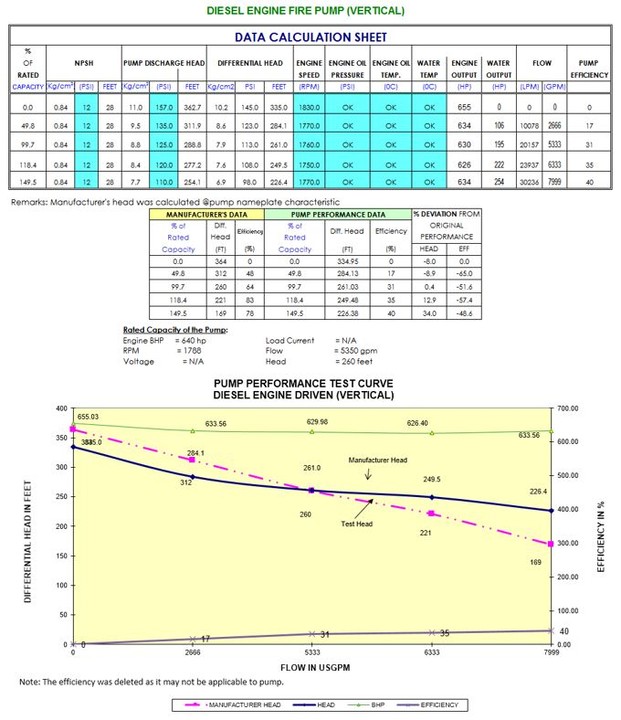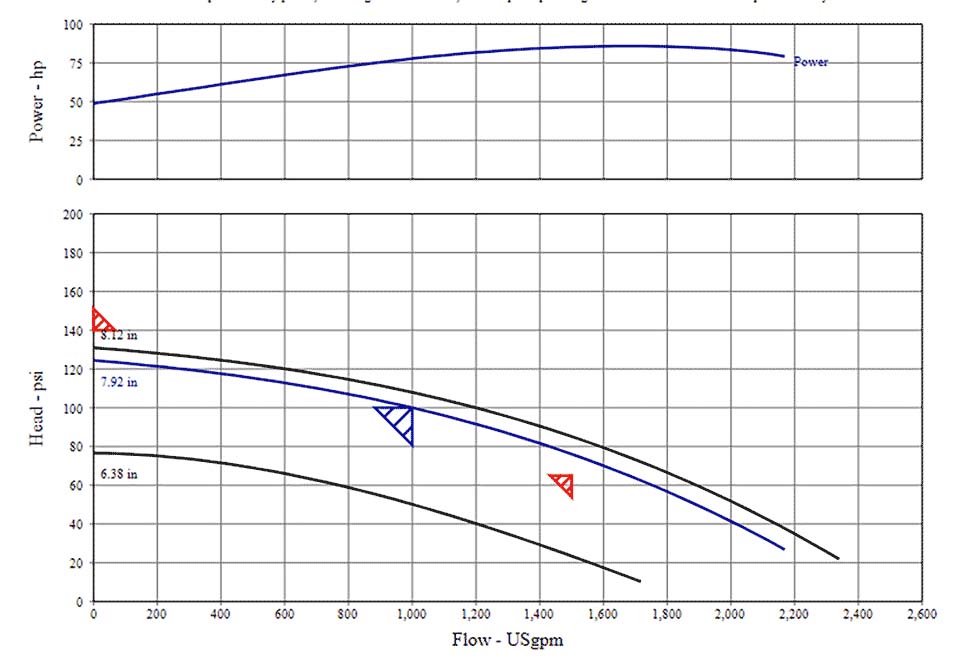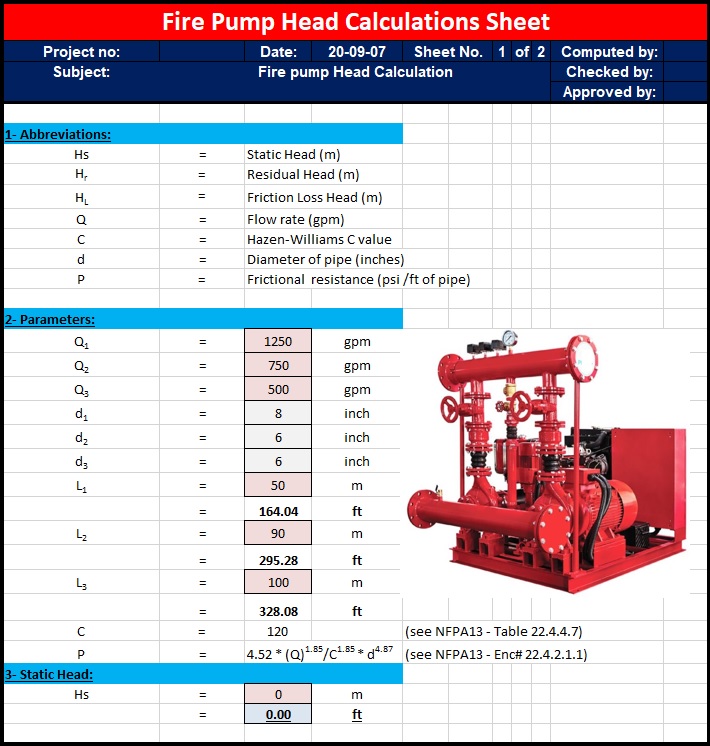To calculate fire pump capacity, determine the flow rate and pressure required for your system. Use NFPA 20 standards for guidance.
Fire pump calculations are essential for ensuring proper fire protection in buildings. Accurate calculations help determine the necessary pump size and capacity to meet safety standards. The flow rate, measured in gallons per minute (GPM), and the pressure, measured in pounds per square inch (PSI), are key factors.
Following the NFPA 20 standards guarantees compliance with fire safety regulations. Engineers and designers must understand these calculations to create effective fire protection systems. Properly sized fire pumps ensure adequate water supply during emergencies, safeguarding property and lives. This practice not only meets legal requirements but also enhances overall building safety.
Introduction To Fire Pump Calculations
Understanding fire pump calculations is essential for ensuring fire safety. These calculations help determine the right pump size and capacity. This guarantees efficient water flow to extinguish fires.
Importance In Fire Safety
Fire pump calculations are crucial in fire safety. They ensure the fire pump meets required standards. Proper calculations can prevent fire-related damages and save lives.
Fire pumps provide water at the right pressure during emergencies. Inadequate pressure or flow can lead to failure in controlling fires. Thus, accurate calculations are vital.
Basic Concepts
To understand fire pump calculations, you need to grasp some basic concepts.
- Flow Rate: The volume of water delivered per minute.
- Pressure: The force needed to move water through the system.
- Pump Capacity: Maximum water volume the pump can handle.
Here’s a simple table to illustrate these concepts:
| Concept | Definition |
|---|---|
| Flow Rate | Volume of water per minute (GPM) |
| Pressure | Force needed to move water (PSI) |
| Pump Capacity | Max water volume pump can handle (GPM) |
To ensure accuracy, always follow guidelines and standards. This guarantees that the fire pump will function correctly during an emergency.

Types Of Fire Pumps
Fire pumps are crucial for fire safety. They move water to fight fires. Understanding the types of fire pumps can help you choose the right one. We will discuss two main types: Centrifugal Pumps and Positive Displacement Pumps.
Centrifugal Pumps
Centrifugal pumps are common in fire protection. They use a rotating impeller to move water. The impeller spins and creates pressure. This pressure moves water through the pump and out to the fire hoses.
Centrifugal pumps come in different types:
- End Suction Pumps: Simple and easy to maintain.
- Horizontal Split Case Pumps: Efficient and reliable.
- Vertical Turbine Pumps: Ideal for deep wells.
| Type | Feature |
|---|---|
| End Suction Pumps | Simple, easy maintenance |
| Horizontal Split Case Pumps | Efficient, reliable |
| Vertical Turbine Pumps | Good for deep wells |
Positive Displacement Pumps
Positive displacement pumps move a fixed amount of water with each cycle. They are great for high-pressure needs. These pumps work well when the water supply is limited.
Types of positive displacement pumps include:
- Gear Pumps: Simple and compact.
- Piston Pumps: High pressure and precise.
- Diaphragm Pumps: Handles dirty water well.
| Type | Feature |
|---|---|
| Gear Pumps | Simple, compact |
| Piston Pumps | High-pressure, precise |
| Diaphragm Pumps | Handles dirty water |
Key Parameters In Fire Pump Calculations
Understanding the key parameters in fire pump calculations is crucial. It ensures the fire pump meets safety requirements. These parameters include flow rate and pressure requirements. Each is essential for effective fire safety systems.
Flow Rate
The flow rate is the volume of water the pump delivers. It is measured in gallons per minute (GPM). The required flow rate depends on the size of the building. Larger buildings need a higher flow rate. Fire codes and standards often specify the required flow rate.
- Small buildings: 500-1000 GPM
- Medium buildings: 1000-2000 GPM
- Large buildings: 2000+ GPM
Calculating the correct flow rate is vital. It ensures enough water is available during a fire.
Pressure Requirements
The pressure requirements ensure the water reaches the necessary height and distance. This is measured in pounds per square inch (PSI). The pressure needed depends on the building’s height and layout. It also considers the type of fire suppression system used.
| Building Type | Required PSI |
|---|---|
| Single-story | 40-60 PSI |
| Multi-story | 60-100 PSI |
| High-rise | 100+ PSI |
Correctly calculating pressure requirements ensures the fire pump performs effectively. It maintains safety during emergencies.

Credit: www.pumpsandsystems.com
Formulas And Equations
Understanding fire pump calculation requires mastering key formulas and equations. These calculations ensure that fire pumps deliver the right water pressure and flow rate. Below are essential formulas that you must know.
Bernoulli’s Equation
Bernoulli’s Equation helps us understand fluid dynamics. It is crucial for calculating pressure in fire pumps. The equation is:
P + 0.5 ρ v^2 + ρ g h = constant
In this equation:
- P: Pressure energy
- ρ: Fluid density
- v: Fluid velocity
- g: Gravitational acceleration
- h: Height above the reference point
Example Calculation:
If you have a fluid velocity of 3 m/s, a density of 1000 kg/m³, and a height of 10 meters, you can plug these values into Bernoulli’s Equation to find the pressure.
Pump Affinity Laws
The Pump Affinity Laws are another set of important formulas. They help you understand how changes affect the performance of fire pumps. The key affinity laws are:
- Flow Rate (Q) ∝ Speed (N)
- Head (H) ∝ Speed² (N²)
- Power (P) ∝ Speed³ (N³)
Example Calculation:
If the speed of a pump is doubled, the flow rate will also double. The head will increase four times, and the power requirement will be eight times greater.
These equations ensure the fire pump meets the required performance standards. Make sure to practice these calculations to become proficient.
Common Calculation Mistakes
Fire pump calculations are crucial for ensuring effective fire protection. However mistakes can lead to inadequate performance. Understanding common errors helps in avoiding them. Here are two frequent mistakes in fire pump calculations:
Overestimating Pressure
One common mistake is overestimating the required pressure. This can lead to oversized pumps. Oversized pumps increase costs and consume more energy.
To avoid this, it’s essential to:
- Accurately measure the building’s height.
- Consider the type of sprinkler heads used.
- Account for any elevation differences.
Using accurate measurements prevents unnecessary expenses. It ensures the system operates efficiently.
Ignoring Friction Loss
Another frequent error is ignoring friction loss. Friction loss occurs when water flows through pipes. It reduces the actual pressure available at the sprinkler heads.
Key factors affecting friction loss include:
- Pipe length and diameter.
- Type of pipe material.
- Number of bends and fittings.
Consider these factors to calculate friction loss accurately. Use the Hazen-Williams formula for better precision. This ensures the pump provides adequate pressure.
Understanding these common mistakes helps improve fire pump calculations. Accurate calculations lead to cost savings and better performance.
Practice Questions: Basic Level
Welcome to the Basic Level practice questions for fire pump calculations. Here, you’ll find easy questions to help you understand flow rates and pressure determinations. Let’s get started with some basic concepts.
Simple Flow Rate Calculations
Flow rate is the volume of water a pump delivers over time. Knowing how to calculate it is essential. Here’s a basic question to get you started:
- Question: A pump delivers 100 gallons of water in 2 minutes. What is the flow rate in gallons per minute (GPM)?
- Answer: Divide 100 gallons by 2 minutes. The flow rate is 50 GPM.
Now, try this one:
- Question: A pump delivers 300 liters of water in 3 minutes. What is the flow rate in liters per minute (LPM)?
- Answer: Divide 300 liters by 3 minutes. The flow rate is 100 LPM.
Basic Pressure Determinations
Pressure is the force exerted by the water flowing through the pump. It’s vital to understand how to calculate it. Here’s a simple question:
- Question: A pump has a pressure of 20 psi. How much pressure will it have if it doubles its flow rate?
- Answer: If the flow rate doubles, pressure also doubles. So, the new pressure is 40 psi.
Try another one:
- Question: A pump works at 10 psi. If the flow rate increases by 3 times, what is the new pressure?
- Answer: Triple the flow rate and the pressure triples. The new pressure is 30 psi.
Practice Questions: Intermediate Level
Fire pump calculation is a vital skill for engineers. Intermediate-level questions test your understanding of more complex scenarios. Here, we will cover two main areas: Complex Scenarios and Multiple Pump Systems.
Complex Scenarios
Intermediate questions often involve complex scenarios. These scenarios simulate real-world conditions. It would help to consider various factors like pressure, flow rate, and pump efficiency.
- Calculate the pump pressure for a multi-story building.
- Determine the flow rate needed for a large industrial facility.
- Assess the impact of pipe friction on pump performance.
| Scenario | Required Calculation |
|---|---|
| Multi-story building | Pump pressure |
| Industrial facility | Flow rate |
| Pipe friction | Pump performance |
Multiple Pump Systems
In some cases, multiple pump systems are needed. These systems can be complex to calculate. You must understand how to balance flow and pressure between pumps.
- Calculate the combined flow rate of two parallel pumps.
- Determine the pressure requirements for a series pump system.
- Analyze the efficiency of a backup pump in a dual-pump setup.
Here is an example code snippet for calculating the combined flow rate:
let pump1Flow = 100; // in GPM
let pump2Flow = 150; // in GPM
let combinedFlow = pump1Flow + pump2Flow;
console.log("Combined Flow Rate: " + combinedFlow + " GPM");
Understanding these intermediate-level questions is crucial. They prepare you for advanced challenges in fire pump calculations.
Practice Questions: Advanced Level
Fire pump calculations require precision and understanding. Advanced-level questions help you master complex systems. You will encounter real-world scenarios and integration challenges.
Real-world Applications
Advanced questions cover real-world applications. These situations test your knowledge and skills. You will learn to calculate pump needs for large buildings.
- High-rise buildings
- Industrial facilities
- Commercial complexes
Solving these problems requires understanding various factors. These include water pressure, flow rates, and pipe friction.
System Integration Challenges
System integration poses unique challenges. You must ensure pumps work with existing systems. This requires in-depth knowledge of system compatibility.
Here are some integration challenges:
- Matching pump capacity with system demand
- Ensuring compatibility with existing fire safety protocols
- Maintaining optimal flow and pressure
Successfully integrating a fire pump involves detailed calculations. You need to consider the entire fire protection system.
Tips For Mastery
Mastering fire pump calculation practice questions is essential for your success. This section covers key tips to help you ace these questions. Focus on time management and consistent review for better results.
Time Management
Effective time management is crucial during practice. Allocate specific time slots for each question. A well-structured schedule keeps you on track and improves efficiency.
- Set a timer for each question.
- Practice under exam conditions.
- Keep a steady pace to avoid rushing.
Use a table to manage your time better:
| Task | Time Allotted |
|---|---|
| Read the question | 1 minute |
| Calculate answer | 3 minutes |
| Review answer | 1 minute |
Review And Repetition
Review and repetition are vital for mastering fire pump calculations. Regularly revisit difficult questions and concepts. This reinforces your understanding and boosts retention.
- Review your incorrect answers.
- Understand the mistakes made.
- Repeat the calculations until perfect.
Consistent practice helps identify patterns and common pitfalls. Make use of practice tests to gauge your progress. This iterative process builds confidence and competence.

Credit: www.sfpe.org
Frequently Asked Questions
What Is The Formula For Calculating A Fire Pump?
The formula for calculating a fire pump is: Q = (L * P) / (N * E). Where Q is flow rate, L is length, P is pressure, N is efficiency, and E is elevation.
How To Calculate Gpm Of A Fire Pump?
Calculate GPM of a fire pump using the formula: GPM = (Psi x Efficiency x 1. 10) / 2. 31. Psi is pump pressure. Efficiency is usually around 60-70%.
What Is The Formula For Calculating The Head Of A Fire Pump?
The formula for calculating the head of a fire pump is: Total Head = Static Head + Friction Loss + Pressure Head. This ensures the pump delivers adequate pressure and flow.
What Is The Rule Of Thumb For Fire Pumps?
The rule of thumb for fire pumps is to ensure they meet NFPA 20 standards, providing adequate flow and pressure for fire protection.
Conclusion
Mastering fire pump calculations is essential for safety and efficiency. Practice these questions regularly to boost your skills. Understanding these fundamentals can make a significant difference in real-world applications. Stay dedicated and continue learning to excel in fire pump calculations.

I’m Abdus Sobur, a highly skilled and professional Fire Safety Officer with a passion for safeguarding lives and property. Over the course of my career, I’ve conducted numerous successful fire safety audits, earning a reputation for excellence in ensuring public safety.
In addition to my role as a Fire Safety Officer, I’m also dedicated to raising awareness about the importance of fire safety. Through my blog, I share insights into the functions of different fire safety equipment, aiming to empower individuals with the knowledge they need to protect themselves and their communities.
I’m driven by a deep commitment to promoting fire safety awareness and preventing fire-related incidents.

